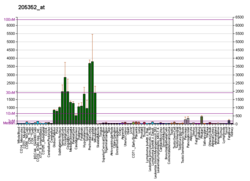| SERPINI1 | |||||||||||||||||||||||||||||||||||||||||||||||||||
|---|---|---|---|---|---|---|---|---|---|---|---|---|---|---|---|---|---|---|---|---|---|---|---|---|---|---|---|---|---|---|---|---|---|---|---|---|---|---|---|---|---|---|---|---|---|---|---|---|---|---|---|
 | |||||||||||||||||||||||||||||||||||||||||||||||||||
| |||||||||||||||||||||||||||||||||||||||||||||||||||
| Identifiers | |||||||||||||||||||||||||||||||||||||||||||||||||||
| Aliases | SERPINI1 , PI12, neuroserpin, serpin family I member 1, HNS-S2, HNS-S1 | ||||||||||||||||||||||||||||||||||||||||||||||||||
| External IDs | OMIM: 602445; MGI: 1194506; HomoloGene: 21045; GeneCards: SERPINI1; OMA:SERPINI1 - orthologs | ||||||||||||||||||||||||||||||||||||||||||||||||||
| |||||||||||||||||||||||||||||||||||||||||||||||||||
| |||||||||||||||||||||||||||||||||||||||||||||||||||
| |||||||||||||||||||||||||||||||||||||||||||||||||||
| |||||||||||||||||||||||||||||||||||||||||||||||||||
| |||||||||||||||||||||||||||||||||||||||||||||||||||
| Wikidata | |||||||||||||||||||||||||||||||||||||||||||||||||||
| |||||||||||||||||||||||||||||||||||||||||||||||||||
Neuroserpin is a protein that in humans is encoded by the SERPINI1 gene. [5]
Contents
It is associated with Familial encephalopathy with neuroserpin inclusion bodies.
Serine protease inhibitors of the serpin superfamily are involved in many cellular processes. Neuroserpin was first identified as a protein secreted from the axons of dorsal root ganglion neurons (Stoeckli et al., 1989). It is expressed in the late stages of neurogenesis during the process of synapse formation.[supplied by OMIM] [5]





